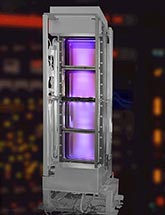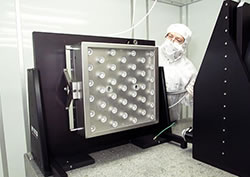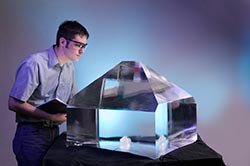The Seven Wonders of NIF
While construction of the football-stadium-sized National Ignition Facility was a wonder of engineering (see An Engineering Marvel), NIF is also a tour de force of science and technology development. To put NIF on the path to ignition experiments in 2010, scientists, engineers, and technicians had to overcome a daunting array of challenges.
Working closely with industrial partners, the NIF team found solutions for NIF's optics in rapid-growth crystals, continuous-pour glass, optical coatings, and new finishing techniques that can withstand NIF's extremely high energies. The team also worked with companies to develop pulsed-power electronics, innovative control systems and advanced manufacturing capabilities. Seven technological breakthroughs in particular were essential for NIF to succeed:
1. Faster, Less Expensive Laser Glass Production
Laser glass is the heart of the NIF laser system; it's the material that amplifies the laser light to the very high energies required for experiments.  NIF's laser glass is a phosphate glass that contains a chemical additive with atoms of neodymium. The NIF laser system uses about 3,070 large plates of laser glass. Each glass plate is about three feet long and about half as wide. If stacked end-to-end, the plates would form a continuous ribbon of glass 1.5 miles long. To produce this glass quickly enough to meet construction schedules, NIF uses a new production method developed in partnership with two companies—Hoya Corporation, USA and Schott Glass Technologies, Inc.—that continuously melts and pours the glass. Once cooled, the glass is cut into pieces that are polished to the demanding NIF specifications.
NIF's laser glass is a phosphate glass that contains a chemical additive with atoms of neodymium. The NIF laser system uses about 3,070 large plates of laser glass. Each glass plate is about three feet long and about half as wide. If stacked end-to-end, the plates would form a continuous ribbon of glass 1.5 miles long. To produce this glass quickly enough to meet construction schedules, NIF uses a new production method developed in partnership with two companies—Hoya Corporation, USA and Schott Glass Technologies, Inc.—that continuously melts and pours the glass. Once cooled, the glass is cut into pieces that are polished to the demanding NIF specifications.
2. Large Aperture Optical Switches
A key element of the amplifier section of NIF's laser beampath is an optical device called a plasma electrode Pockels cell, or PEPC,  that contains a plate of potassium dihydrogen phosphate (KDP). This device, in concert with a polarizer, acts as a switch—allowing laser beams into the amplifier and then rotating its polarization to trap the laser beams in the amplifier section. A thin plasma electrode that is transparent to the laser wavelength allows a high electric field to be placed on the crystal, which causes the polarization to rotate. The trapped laser beams can then increase their energy much more efficiently using multiple passes back and forth through the energized amplifier glass. After the laser beams make four passes through the amplifiers, the optical switch rotates their polarization back to its normal configuration, letting them speed along their path to the target chamber.
that contains a plate of potassium dihydrogen phosphate (KDP). This device, in concert with a polarizer, acts as a switch—allowing laser beams into the amplifier and then rotating its polarization to trap the laser beams in the amplifier section. A thin plasma electrode that is transparent to the laser wavelength allows a high electric field to be placed on the crystal, which causes the polarization to rotate. The trapped laser beams can then increase their energy much more efficiently using multiple passes back and forth through the energized amplifier glass. After the laser beams make four passes through the amplifiers, the optical switch rotates their polarization back to its normal configuration, letting them speed along their path to the target chamber.
3. Stable, High-Gain Preamplifiers
NIF uses 48 preamplifier modules, or PAMs, each of which provides laser energy for four NIF beams. The PAM receives a very low energy (billionth of a joule) pulse from the master oscillator room and amplifies the pulse by a factor of about a million, to a millijoule. It then boosts the pulse once again to a maximum of about ten joules by passing the beam four times through a flashlamp-pumped rod amplifier. To perform the range of experiments needed on NIF, the PAMs must perform three kinds of precision shaping of the input laser beams.

- Spatial shaping to make the square beam more intense around the edges to compensate for the higher gain profile in the center of the large amplifiers.
- Spectral shaping and beam smoothing to eliminate both hot spots and dark spots at the focus by manipulating the focal beam pattern with fast changes in wavelengths.
- Temporal shaping to ensure that the laser pulse delivers energy to the target with a prescribed time-history for efficient ignition.
4. Deformable Mirrors
The deformable mirror is an adaptive optic that uses an array of actuators to bend its surface to compensate for wavefront errors in the NIF laser beams. There is one deformable mirror for each of NIF's 192 beams. Advances in adaptive optics  in the atomic vapor laser isotope separation (AVLIS) program at Lawrence Livermore National Laboratory demonstrated that a deformable mirror could meet the NIF performance requirement at a feasible cost. Livermore researchers developed a full-aperture (40-centimeter-square) deformable mirror that was installed on the Beamlet laser in early 1997. Prototype mirrors from two vendors were also tested in the late 1990s. The first of NIF's deformable mirrors were fabricated, assembled and tested at the University of Rochester's Laboratory for Laser Energetics and installed and successfully used on NIF to correct wavefronts for the first beams sent to target chamber center (see NIF Early Light).
in the atomic vapor laser isotope separation (AVLIS) program at Lawrence Livermore National Laboratory demonstrated that a deformable mirror could meet the NIF performance requirement at a feasible cost. Livermore researchers developed a full-aperture (40-centimeter-square) deformable mirror that was installed on the Beamlet laser in early 1997. Prototype mirrors from two vendors were also tested in the late 1990s. The first of NIF's deformable mirrors were fabricated, assembled and tested at the University of Rochester's Laboratory for Laser Energetics and installed and successfully used on NIF to correct wavefronts for the first beams sent to target chamber center (see NIF Early Light).
5. Large, Rapid-Growth Crystals
NIF's KDP crystals serve two functions: frequency conversion and polarization rotation (see Optical Switch). The development of the technology to quickly grow high-quality crystals was a major undertaking and is perhaps the most highly publicized technological success of the NIF project. NIF laser beams start out as infrared light, but the interaction of the beams with the fusion target is much more favorable if the beams are ultraviolet. Passing the laser beams through plates cut from large KDP crystals converts the frequency of their light to ultraviolet before they strike the target. The rapid-growth process for KDP, developed to keep up with NIF's aggressive construction schedule, is amazingly effective: Crystals that would have taken up to two years to grow by traditional techniques now take only two months. In addition, the size of the rapid-growth crystals is large enough that more plates can be cut from each crystal, so a smaller number of crystals can provide NIF with the same amount of KDP.
NIF laser beams start out as infrared light, but the interaction of the beams with the fusion target is much more favorable if the beams are ultraviolet. Passing the laser beams through plates cut from large KDP crystals converts the frequency of their light to ultraviolet before they strike the target. The rapid-growth process for KDP, developed to keep up with NIF's aggressive construction schedule, is amazingly effective: Crystals that would have taken up to two years to grow by traditional techniques now take only two months. In addition, the size of the rapid-growth crystals is large enough that more plates can be cut from each crystal, so a smaller number of crystals can provide NIF with the same amount of KDP.
6. Target Fabrication
To meet the needs of NIF experiments, NIF's millimeter-sized targets must be designed and fabricated to meet precise specifications for density, concentricity, and surface smoothness. When a new material structure is needed, materials scientists create the necessary raw materials. Fabrication engineers then determine whether those materials—some never seen before—can be machined and assembled. Manufacturing requirements for all NIF targets are extremely rigid.  Components must be machined to within an accuracy of one micrometer, or one-millionth of a meter. In addition, the extreme temperatures and pressures the targets will encounter during experiments make the results highly susceptible to imperfections in fabrication. Thus, the margin of error for target assembly, which varies by component, is strict. Throughout the design process, engineers inspect the target materials and components using nondestructive characterization methods to ensure that target specifications are met and that all components are free of defects. Together, this multidisciplinary team takes an experimental target from concept to reality.
Components must be machined to within an accuracy of one micrometer, or one-millionth of a meter. In addition, the extreme temperatures and pressures the targets will encounter during experiments make the results highly susceptible to imperfections in fabrication. Thus, the margin of error for target assembly, which varies by component, is strict. Throughout the design process, engineers inspect the target materials and components using nondestructive characterization methods to ensure that target specifications are met and that all components are free of defects. Together, this multidisciplinary team takes an experimental target from concept to reality.
7. Integrated Computer Control System
Fulfilling NIF's promise requires one of the most sophisticated computer control systems in government service or private industry. Every NIF experimental shot requires the coordination of complex laser equipment. In the process, some 60,000 control points for electronic, high voltage, optical, and mechanical devices—such as motorized mirrors and lenses, energy and power sensors, video cameras, laser amplifiers, pulse power, and diagnostic instruments—must be monitored and controlled.  The precise orchestration of these parts by NIF's integrated computer control system will result in the propagation of 192 separate nanosecond-long (billionth of a second) bursts of light over a one-kilometer path length. The 192 separate beams must have optical pathlengths equal to within nine millimeters so that the pulses can arrive within 30 picoseconds (trillionths of a second) of each other at the center of a target chamber ten meters in diameter. Then they must strike within 50 micrometers of their assigned spot on a target measuring less than one centimeter long—an accuracy comparable to throwing a pitch over the strike zone from 350 miles away.
The precise orchestration of these parts by NIF's integrated computer control system will result in the propagation of 192 separate nanosecond-long (billionth of a second) bursts of light over a one-kilometer path length. The 192 separate beams must have optical pathlengths equal to within nine millimeters so that the pulses can arrive within 30 picoseconds (trillionths of a second) of each other at the center of a target chamber ten meters in diameter. Then they must strike within 50 micrometers of their assigned spot on a target measuring less than one centimeter long—an accuracy comparable to throwing a pitch over the strike zone from 350 miles away.




